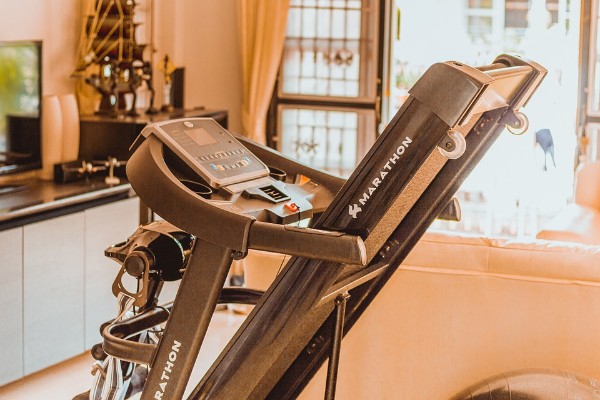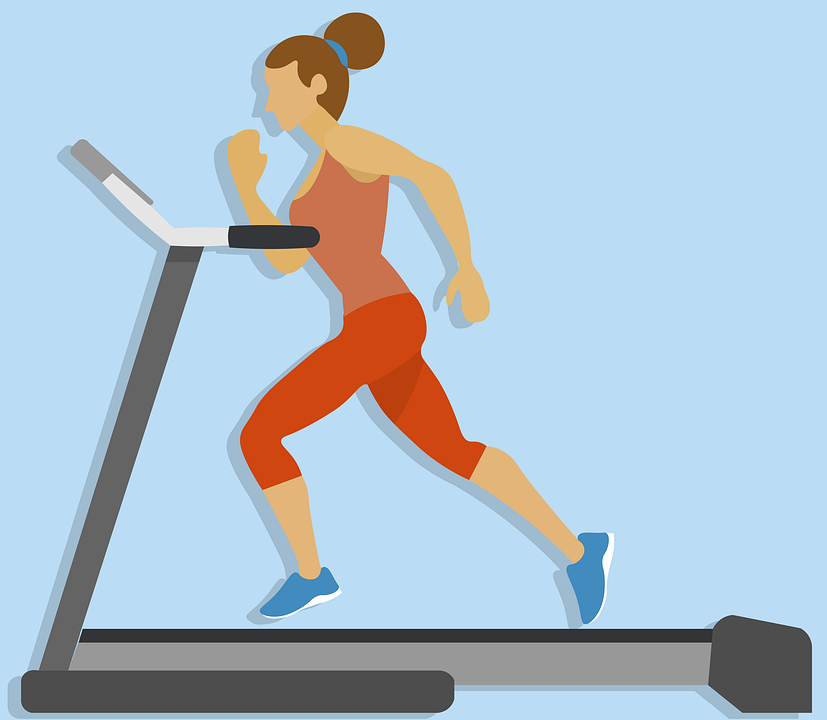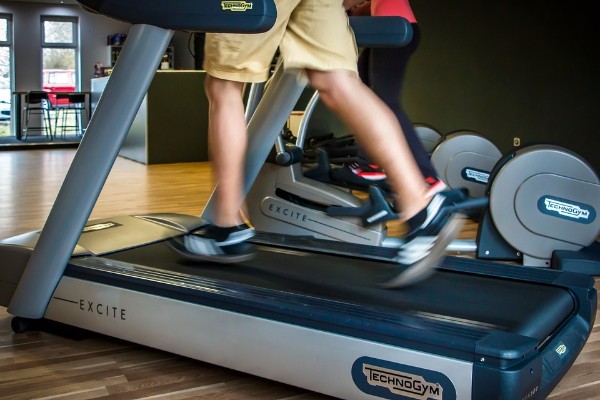There’s no denying that running on a treadmill differs slightly from running outside, but when done correctly, treadmill running can offer just as many (if not more) advantages. The fact that using a treadmill is safe is one of its many benefits. There are no icy patches or inclement weather hazards, uneven terrain, or concerns about running in the early morning or late evening darkness.
“However, what about all those unpleasant treadmill spills I’ve seen on YouTube?” you ask. As unpleasant (and entertaining) as that may be to witness, the majority of those incidents are the result of user error and improper treadmill usage, such as attempting to jump onto a machine that is already running at 10 mph. Following these suggestions will make using a treadmill more efficient, fun, and safe, whether you’re switching from walking to running or simply looking to move your running workouts indoors.
Tips #1: Setup & Safety
Getting Set Up
The right expectations are all you need to have in order to successfully begin running on a treadmill.
Starting slowly is a good idea for any treadmill running exercise. You can change the incline and speed on a treadmill. Use this gift to your advantage. You may not always have the luxury when running on a trail, particularly if you have to climb an uphill slope to begin.
The majority of treadmills measure speed in miles per hour or kilometers per hour. Start off at a walking pace when you turn on the machine, work your way up to a jog, and then safely get to your desired pace.
Usually, the incline is expressed as a percentage. For incline, a typical “hill” like you might find outside is usually between 5-8% grade. If you want to include some hill running in your training, you can start at that range.
Feel free to play around—sometimes I love to take my “flat runs” at a 1% or 2% incline just for an added challenge. Consider adding a bit of incline even on days that aren’t necessarily “hill runs.”
On most treadmills, you can also change the speed and incline using buttons on the handrail in addition to the front of the machine where they are both adjustable. If you need to make quick adjustments, changing the incline or speed on the handrail is a great choice.
Best Way To Run On A Treadmill Safely
All treadmills have an emergency stop function for your safety. The majority of machines will have a magnet that is attached to the treadmill by a thin rope, and when you pull the magnet off, the treadmill will stop.
Consider experimenting with the emergency stop feature before beginning your run. It goes without saying that you should be aware of its location in case you need to stop quickly, but you should also take care to avoid stopping unintentionally as this can be equally hazardous.
Check out these treadmill beginner training tips if you’re a beginner runner or just new to them!
Let’s get started with some treadmill running tips to make the most of your workouts and prevent injuries now that we’ve covered the fundamentals.

Tips #2: Running Form
The use of a treadmill can help you improve your running form and identify any flaws or habits you may have. On a treadmill, there are no cars, obstacles, or other runners to distract you like there are on a road or trail run.
You can fully concentrate on developing proper running form because nothing is in your way. And reducing your risk of injury while running requires using proper form.
Warm Up
It can be tempting to just get on the treadmill and begin working out. But before starting the more difficult part of your run, it’s crucial to warm up, just like when running outdoors.
During a warm-up, your heart rate increases, more oxygen is delivered to your muscles, and their temperature rises, making them more effective. Before picking up the pace or raising the incline, start with a 5-minute stroll or easy jog on the treadmill.
Toes Straight Ahead
Start by noting which way your toes are pointing as your foot makes contact with the ground. Make sure your toes are pointed directly forward. Your natural inclination may be to turn your feet slightly outward or inward, but doing either of these can put a strain on your knees.
Train your body to run with your toes straight ahead on the treadmill. If you find this difficult, slow down and incline the pace instead, and just run at a slow to moderate pace while you align your feet.
Run Tall
The proper running form will be easier to put together if you run with good posture. For instance, if you want to run tall, you should clench your glutes while running.
Your pelvis will remain upright and your hip bones will remain facing forward as a result. Runners frequently allow their hips to revert to a neutral position and disengage their glutes as they grow weary.
Recognize this tendency and correct it by thinking about tightening your glutes and running tall, especially if you are completely out of breath.
When running at an angle, this will become even more crucial. When climbing a hill, our bodies’ natural tendency is to lean forward and rock our hips back. Always maintain a tall posture as you climb.
Along those lines, make sure your upper body, including your head and chest, is upright. Again, jogging as part of your warm-up is a great way to concentrate on these form suggestions. Then, just observe how you run.
Maintaining that proper form when you become fatigued will undoubtedly be difficult. However, mastering proper technique slowly will go a long way.
Good habits can be made into muscle memory, which will (hopefully) benefit you somewhat when fatigue sets in.
Focus On Your Arm Swing
You want a relaxed arm swing that still generates some force. Keep your arms from crossing your body’s midline as you do this. With a linear, front-to-back arm swing, you will generate more power for your run and be less likely to sustain injuries.
The twisting motion that occurs when your arms cross over your midline while you swing them is taxing on the muscles in your torso, which can lead to the lower back and abdominal problems. Additionally, this version uses more energy.
Simply maintain a relaxed, linear swing with your arms, letting the power come from that swing. Check out this article on proper running form from head to toe to learn more about proper running form.

Tips #3: Things to Be Care
Don’t Make It Too Steep
Nevertheless, avoid making the incline too steep (more than 7%); doing so puts too much strain on your back, hips, and ankles.
When they set the goal of finishing their entire run at a steep incline (anything over 2 percent), some runners believe they’re getting a great workout. A lot of straight hill running, however, is never a good idea and can result in accidents. Think about it: A 3-mile hill with a 5- or 6-percent incline would never be found outside.
Spend no more than five minutes running with a steep incline. If you alternate between running for a few minutes at an incline and a few minutes at a flat pace, you’ll get a much better, safer workout. While the flat sections improve stamina and endurance, the uphill segments aid in the development of strength. Try this 30-minute interval workout.
Don’t Hold on to the Handrail Or Console
Some people believe that when using a treadmill to run or walk, they must hold onto the handrails. However, the handrails are only there to make it safer for you to get on and off the treadmill.
Holding on to the rails has a few drawbacks. The first is that it makes you hunch over, which is an ineffective running technique that can cause pain in your neck, shoulders, and back. Do not slouch; maintain an upright stance. Your shoulders should be level, your back should be straight.
DO: Maintaining your arms at a 90-degree angle, as you would if you were running outside, will help you practice proper upper body form.
In reality, you’re lightening your load and making it easier on yourself by holding on to the rails, despite the fact that doing so may make you feel like you can keep up the pace and work harder. Try to run as if the rails are not even there and that you are outside.
You’re probably running too quickly or up too steep an incline if you’re worried about falling. Reduce the incline and/or slow down. Form and safety should come first.
Pay Attention to Your Stride
Running on the treadmill should be performed in the same manner as running outside. Avoid taking short, jerky strides when running and try to follow your natural gait. If you feel like your form is incorrect, slow down until you feel like you are using the right form. then gradually quicken the pace.
Overstriding, which is when you land with your foot well in front of your center of gravity, is another frequent form error. Overstriding causes the treadmill’s belt to slow down because it is moving you forward. Try to keep your feet close to your body rather than in front of or behind it to prevent this. To lessen the force transferred to your legs, keep your stride short.
Don’t Step on Or Off While the Treadmill is Moving
Jumping or falling off a fast-moving treadmill is one of the leading causes of injuries on treadmills.5 If you need to go to the restroom, grab a towel, or get some water, slow the machine down to a very reduced pace and lower the incline. After that, carefully exit. When you get back on, proceed in the same manner; do not attempt to resume your previous speed or incline immediately.
Better yet, make an effort to ensure that you have everything you require, including a towel, water, headphones, etc.—before you start your run, so you won’t be tempted to hop off.
Don’t Forget to Hydrate
Since there is little air resistance to keep you cool while you are running on a treadmill, you can lose even more water than you would if you were outside. Keep a bottle of water close at hand, and consume 4 to 6 ounces of water every 20 minutes of treadmill running.
Close Note: Running on Treadmill Safely & Effectively
The possibilities for your workout when running on a treadmill are virtually endless. Anytime, for any length of time, you can run, jog, or walk. You can access new forms of entertainment and are not restricted by the weather.
Understanding all of the features on your treadmill, having the appropriate equipment, and treating your run as though you were outside will help you get the most out of it. Then, just let yourself go!
FAQs
How To Start Running On The Treadmill?
Start out slowly because the hard-packed, immobile ground you’re used to running on is very different from a treadmill’s bouncy, moving conveyor belt surface.
Don’t rush your ability to adjust. You shouldn’t immediately start running the same distance on the treadmill just because you can run 15 miles outside.
How Fast To Run On The Treadmill?
You can run as fast as you like, just keep in mind that stopping on a treadmill is a bit different than stopping outside. The emergency button must be pulled, you must jump off the treadmill belt onto the sides, or you must gradually reduce your speed. Each option has advantages and disadvantages.
How Long Does To Run On The Treadmill?
Start by going for 20-minute runs three times a week. Increase both the length of time you run and the number of days you run gradually, but don’t do either until you feel confident finishing your current level of training. Take walking breaks if 20 minutes is too long.
Read More: Why Is Treadmill Belt Slipping & How To Fix
What Do 15 Incline Treadmills Mean?
